An upright row has been a part of bodybuilder workouts for decades. It’s a regular inclusion in male workouts in gyms. However, this particular exercise improves aesthetics and functionality and, thus, has to be included in a regime no matter the gender.
The upright row is an effective shoulder and upper back exercise that targets the following muscles:
- side deltoids
- trapezius muscles
These are the prime movers. Supportive muscles are
- front delts
- rhomboids
- teres minor
And though there is a tendency to train shoulder muscles with mostly isolated exercises among beginners, this compound movement targets the whole area in an efficient way. Therefore, it should be included in all upper-body regimes.
Unfortunately, such an effective exercise comes with its dangers. During the peak of the movement, your shoulders shift to a compromised position. If done incorrectly or with weights too heavy, you can injure your shoulders. This is why it’s of utmost importance to keep the proper form. Plus, knowing a few alternative exercises targeting the same muscle groups can prevent injuries and help you choose exercises that feel most natural for your movements.
But let’s start with discussing the proper form for the upright row so you can try the exercise yourself.
How to Do Upright Row
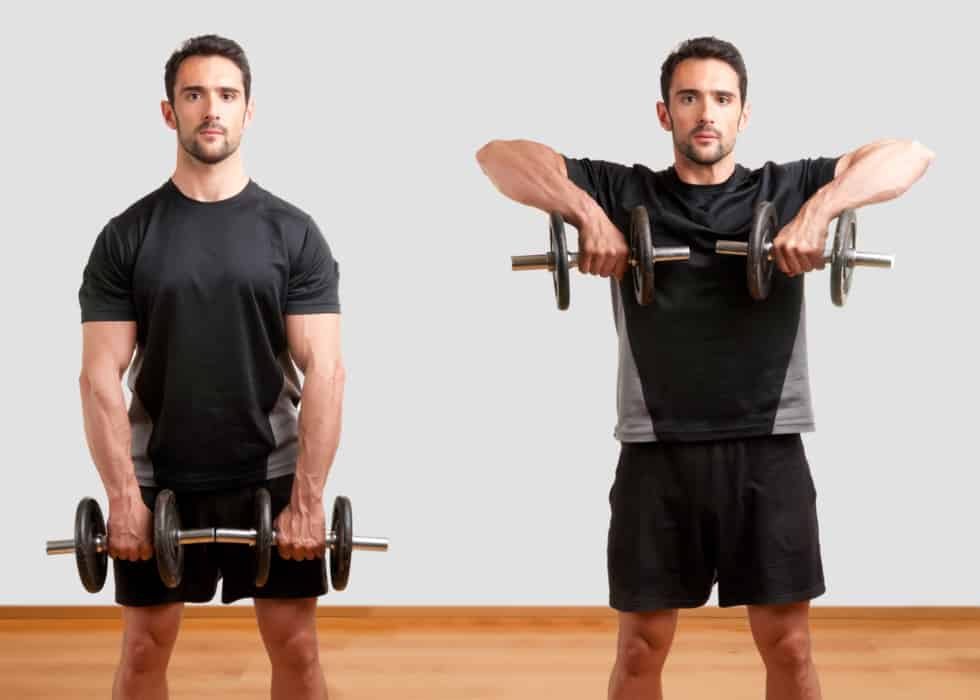
- Stand with your feet shoulder-width apart. A barbell in your hands (overhand grip – palms facing your body. Your back should be straight, chest up, core engaged.
- Lift the barbell straight up towards your chin. Elbows should be going to the sides and up, rm parallel to the ground – not higher!
- Hold for a second and lower the barbell to the starting position.
- Better posture – by strengthening your shoulders, upper back, and core in many of the variations, you improve your posture drastically. Years of desk studies and work does nothing good to our upper body. Strengthening it is an effective way to stand straighter.
That is the entire sequence. It’s a simple exercise on paper. In practice, you have to be extra careful about the possible injuries. Do not raise your arms too high. Not higher than parallel to the ground; slightly lower is also allowed.
11 Best Dumbbell Exercises for Lats: All Levels
Upright Row Benefits
Among the benefits of the upright row, and basically, the 11 exercises of this article (as they target the same muscle group) are the following.
- Increased upper body strength. Training shoulders is a tedious task. And when you get a compound exercise that works perfectly, you only require consistency to strengthen your arms, shoulder, and back. As a result, all the other pulling and lifting exercises become drastically easier and allow you to go further in your training routine.
- Improved daily activities. The same lifting and pulling motions are used every day in our lives. It’s used when lifting shopping bags, carrying our backpacks, wiping the floors, etc.
- Aesthetics. You cannot argue that toned well-defined delts and trapezius loo are appealing. And even the slightest definition makes a person look toned and fit overall. When asked, people wouldn’t enlist shoulder among the top visual muscles, but, in reality, your eyes go straight to the upper body initially.
So, in the future, I hope you’ll include the following upright row alternatives into your workout schedule while maintaining safety precautions.
Upright Row Alternatives
Barbell High Pull
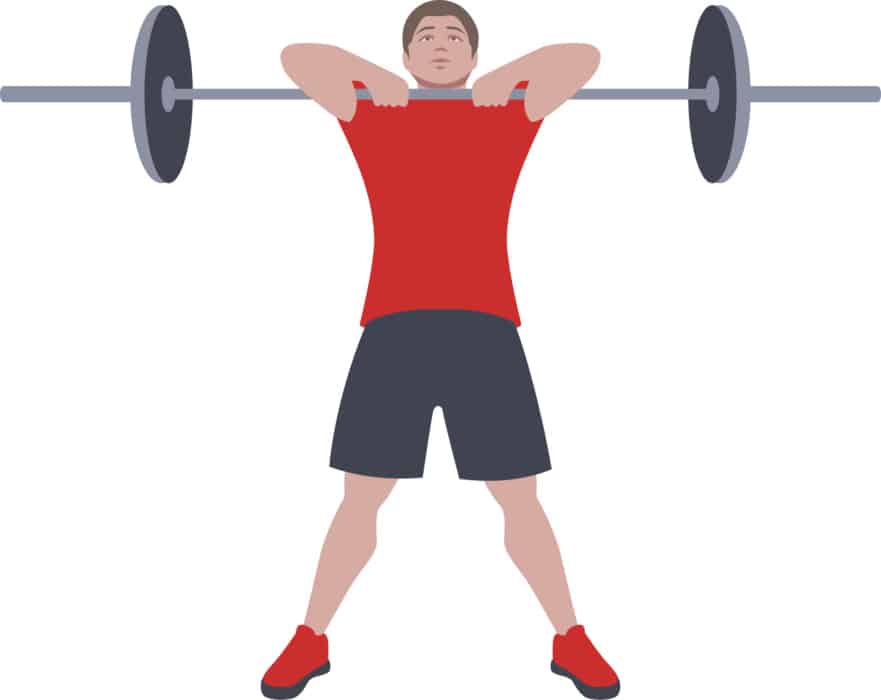
In this first exercise, I’d like to cover a close sibling of the upright row that should be done mainly by intermediate and advanced athletes to avoid severe injuries. In addition to the upper traps, it also engages mid and lower traps, thus improving your posture overall. Plus, it targets the posterior chain and core as a stabilization mechanism.
How to do:
- Stand with your feet shoulder-width apart. Take the barbell in an overhand grip slightly further than your feet-width.
- Hinge at your hips and lower your torso until it’s almost parallel to the floor.
- In an explosive movement, drive your feet through the floor, rise to your toes, straighten and bring the barbell up in a straight line. Shrug the shoulders and raise the bar to your chin. Remember to keep your elbows higher than the wrists.
- Lower the barbell to the floor and repeat.
Stop immediately if you feel any discomfort in your shoulders during this exercise. In the future, you may better benefit from some other alternative to upright row.
5-Day German Volume Training Plan
Seated Muscle Snatch
This one is yet another highly technical shoulder exercise. However, due to shoulder rotation at the top of the movement, the exercise doesn’t compromise your shoulder as much as the upright row does.
Among the worked muscles are
- traps
- delts
- middle back
- triceps
Core engages in stabilization. This exercise is used to increase pulling strength as well as the barbell trajectory and balance in the pull. There is also a standing snatch variety, but it’s more of a full-body exercise, and we are targeting shoulders today.
Note that there are two variations of the movement. I’ll cover the differences in the steps.
How to Do:
- Seat on a bench, barbell in your lap. Use a barbell only with no added weights.
- In an explosive motion, start lifting the barbell up as you would in an upright row. When your elbow reaches shoulder level, perform a barbell turnover and continue rising it to the full arm length upward and slightly back. In the second option, the upper body goes noticeably more backward, and the elbow drop during rotation.
Check this video to get the full technical grasp with visual representation to notice the difference.
Single Arm Dumbbell Power Snatch
This exercise is the single-arm variation of the previous alternative. Plus, it’s a standing version that also engages the posterior chain and core to a larger degree. Similar one-arm exercises bring all the focus to one side and work it to the maximum. In addition, one-arm exercises are used to alleviate any imbalances that appear during compound motions.
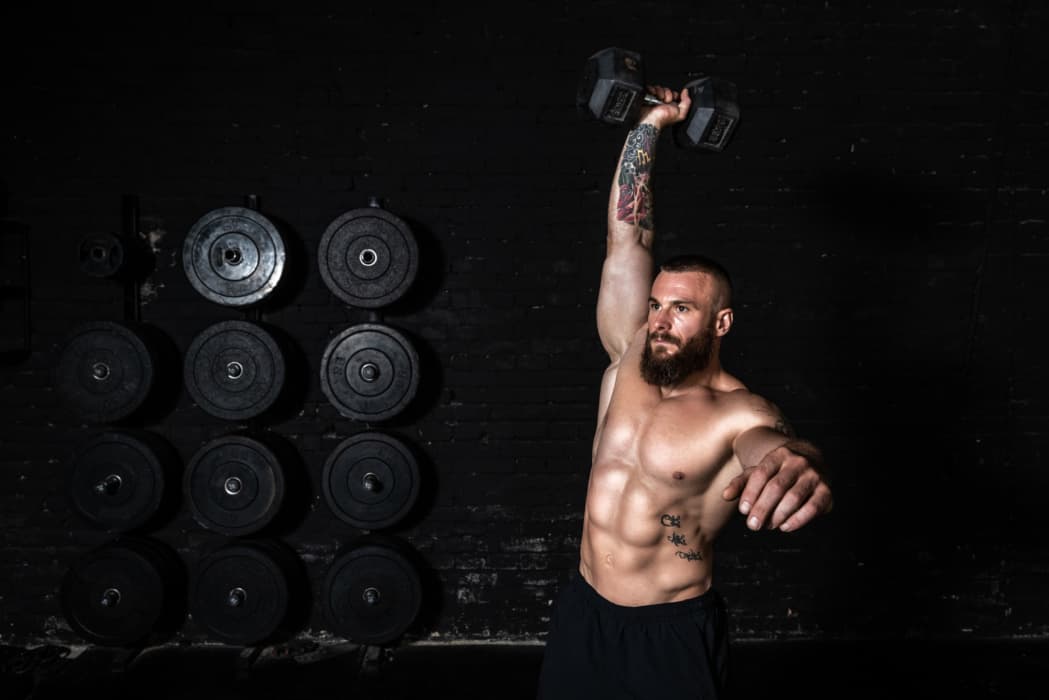
How to do:
- Stand straight. Feet shoulder-width apart, a dumbbell between them.
- Hinge your hips back and lower into a deadlift-like position. Grab the dumbbell with one hand and extend the freehand slightly back. Hamstring and core engaged!
- Push the feels into the ground and up. Keep the elbow locked for now.
- As you straighten, aster the full extension of the knees and hips, pull the elbow up, and lockout overhead. Keep the dumbbell as close as possible to the body.
- Lower the dumbbell to the ground. Repeat this with the same hand or alternate.
Kettlebell swing
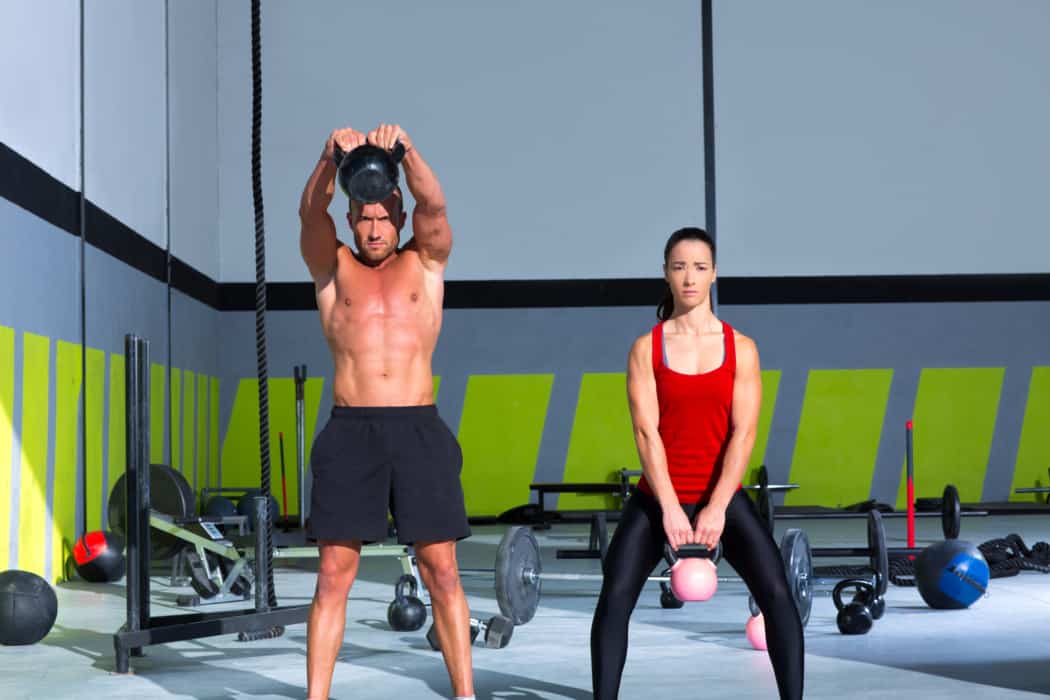
A kettlebell swing is quite different from the previous exercises. It utilizes the whole body just like the snatches but incorporates momentum. The swing is a compound full-body movement that engages traps in a safer motion than the upright row. Plus, delts work as assisting muscles to a lesser extent. And this is yet another exercise that engages the posterior chain in full-body movements.
7 Best Core Exercises to Build Strength at Home
How to do
- Stand straight with your feet shoulder-width apart. Hold a kettlebell in both arms (straight).
- Engage your core, hinge your hips, and slightly bend the knees. A kettlebell should be placed between your legs. Keep the back straight throughout the whole exercise.
- Push your hips forward and stand up. At the same time, swing the kettlebell forward and up. Stop when your straight ars are parallel to the ground. If your arm doesn’t rise to this level naturally, without straining the arms, let them stop lower.
- In a controlled motion, return to the previous position. Find a bisk yet steady rhythm for the following reps, no rest in-between.
Dumbbell Lateral Raise
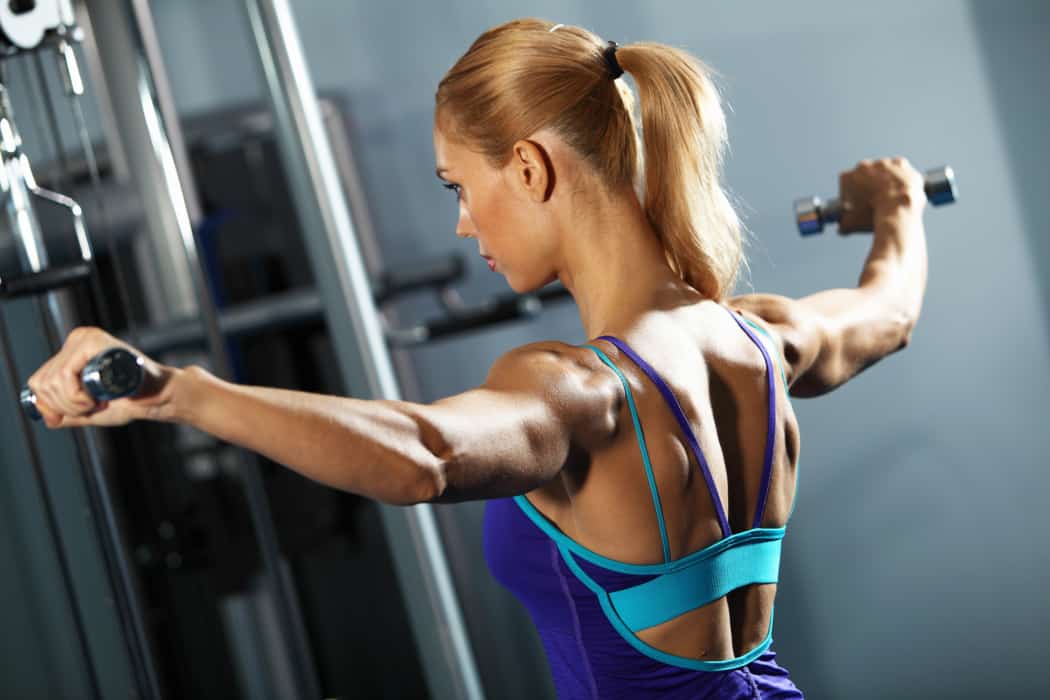
A dumbbell raise is usually a bilateral exercise though you’ll see unilateral versions on occasion as well.
This exercise targets anterior and lateral delts as well as serratus anterior. This is generally considered one of the best shoulder exercises, but it comes with similar concerns as the upright row. Thus, remember to select appropriate weights and don’t raise your elbows high.
Overall, when compared with the upright row, these two exercises are equal in efficiency. However, most gym-goers prefer this alternative due to better engagement of lateral delts.
How to do:
- Stand straight with feet shoulder-width apart. Take dumbbells in each hand. Let them hang for a bit.
- Engage your upper body and raise your arms to the sides and up until you are parallel to the floor. Keep your elbows slightly bent.
- Pause at the tp for a second and lower the dumbbells to the starting position.
The most crucial rule – elbows no higher than shoulders.
Banded Lateral Raise
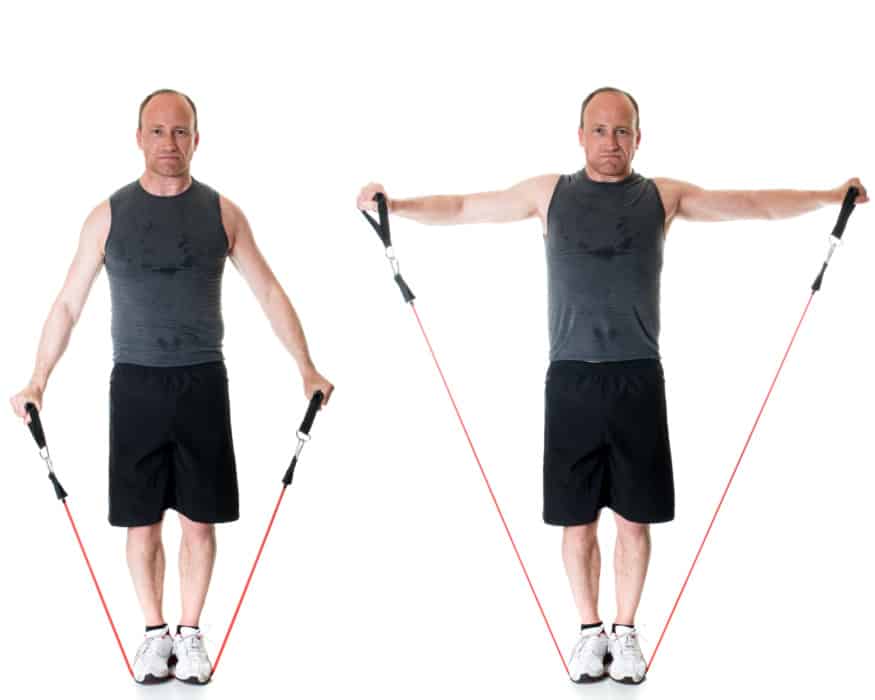
If it so happens that you have no dumbbells are home but have resistance bands (or you are vacationing with a couple of bands to keep your form), this can be a great alternative of the same efficiency. This exercise offers exactly the same muscle engagement as the dumbbell lateral raise but can be more “mobile,” so to say, due to the portability of the bands.
How to do:
- Take a pair of long resistance bands or one large. Step your feet in the middle (or on the two ends).
- While keeping your back straight, engage your upper body and raise your arms to the sides and up until they are parallel to the floor. Keep your elbows slightly bent.
- Pause at the top for a second and lower your hands to the starting position.
5 Best Tricep Workouts With Dumbbells
Dumbbell YTW
This is quite an interesting exercise that primarily targets low and mid traps, plus infraspinatus. The whole set is known as the Y-T-W. The “Y” position focuses on the low trap, “T” on the mid trap, and ‘W” on isometric contractions on the infraspinatus and teres.
How to do:
- Lie on an incline bench (your torso going up). Take a dumbbell in each hand. Let them hang for now slightly in front of the body. Take the lightest dumbbell possible or start with bodyweight.
- Retract the shoulder blades, and extend and raise your arms in the shape of a “Y” (thumbs upward, arms slightly outside the shoulders). Lower the dumbbells.
- Retract shoulder blades, extend and raise your arms to the sides in the shape of a “T” (thumbs up, a straight line from one hand to the other. Lower the dumbbells.
- “Hammercurl” the dumbbell to 90 degrees. Elbows directly underneath the shoulder extend and raise your arms to the sides in the shape of a “T” Hinge from the shoulder, bring elbows up to the sides and hold. Slowly bring elbows down.
Yes, this is a complex exercise in its technicality. Thus, I’ll better add a comprehensive video provided by Trainer Hub.
Overhead Barbell Carry
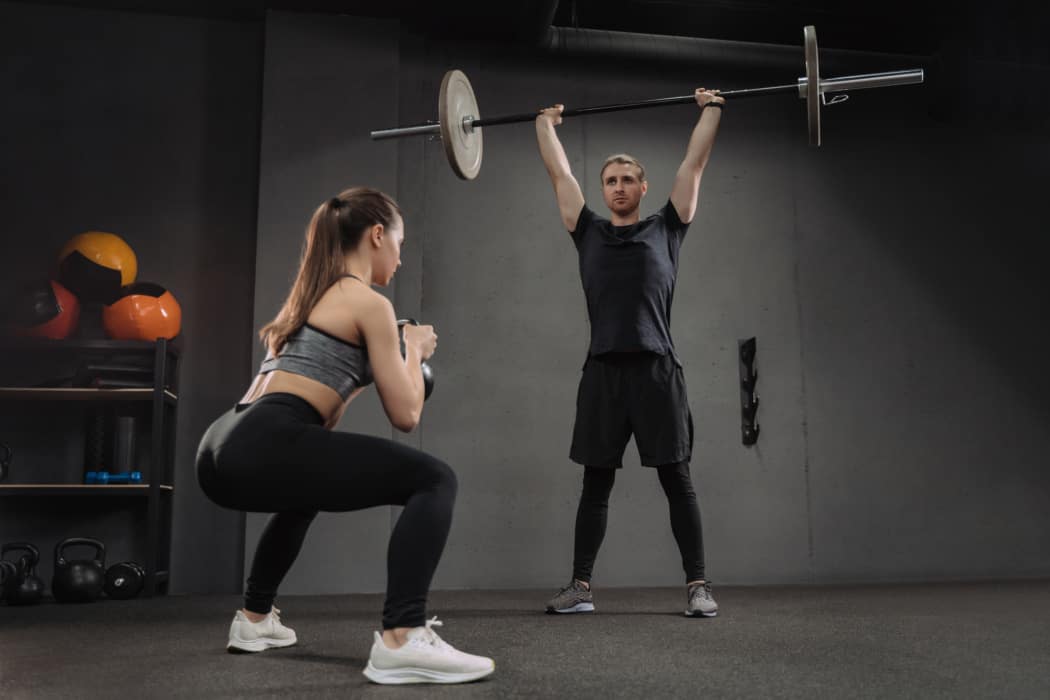
- abs
- hamstrings
- lower back
- quads
- shoulders
- traps
- upper back
It may seem like a lacking exercise due to its static nature in the upper body, but the isometric contractions should not be excluded from a workout plan.
How to do:
- Set a bar at your chest height on the rack. Sit with your back to it.
- Take the bar and bring it up in the overhead position (you can also do that from the floor like the “snatch” movement.
- With the barbell on top, stabilize your position. Your whole body would be in a straight line.
- From there, start walking. Maintain a strong core and push up on the bar. The upper body stays concrete, unmovable. Move slowly and under control.
TRX Inverted Row

If your gym has TRX equipment, you can choose this alternative to an upright row. In general, TRX trains balance and coordination alongside strength, so it would be a nice addition to your regular workouts.
The exercise mainly focuses on the back, biceps, and shoulders. This compound exercise can be used on your full-body days. If you’ve never worked with TRX, ask a trainer for help.
How to do:
- Adjust TRX to middle-length. Grab the handles and hang them down directly under the straps.
- Anchor through the heels and form a straight plank position. The whole body at around 45 degrees. Palms should be facing inwards.
- Brace your core and pull up your body until the straps touch your chest. Shoulderblades should go down.
- Lower back to the incline plank position.
Cable Upright Row
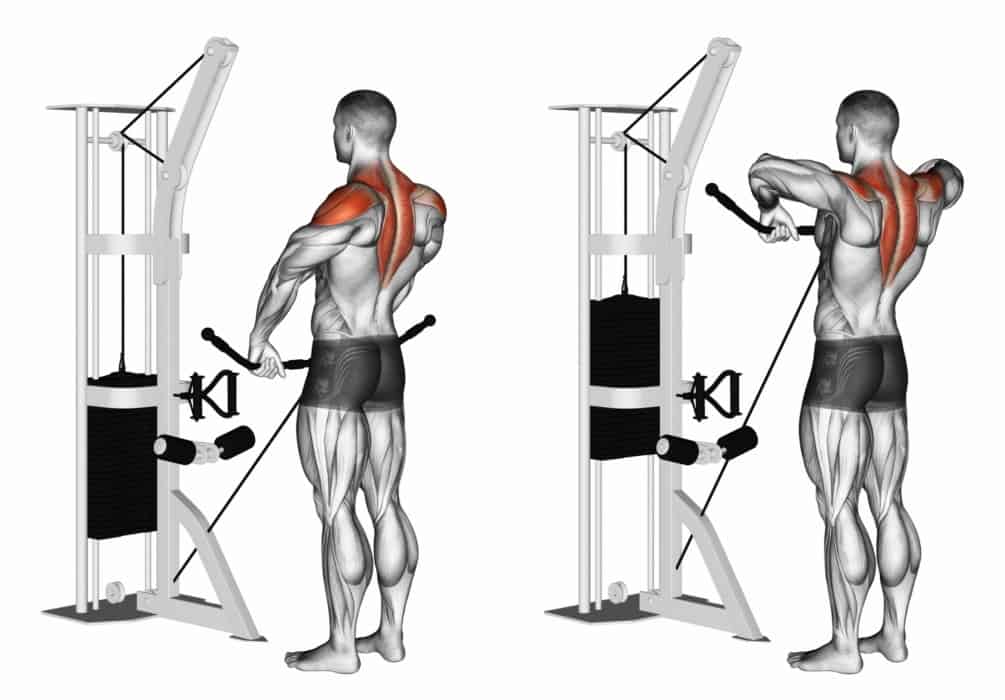
One of the biggest benefits of gyms for me is the addition of a cable pulley machine. This is solely the most essential piece of equipment that can be used to train any muscle in your body. Seriously! You name a muscle, and I can find several cable exercises for it.
Now, back to our shoulders. There are two great cable alternatives. The first of the cable upright row. The movement targets the same muscles as the barbell upright row.
How to do:
- Attach a straight bar to the cable. Stand in front of a cable machine, feet shoulder-width apart. Anchor through your feet, back straight, chin tucked (and it should remain so throughout the full exercise.
- Hold the bar in front of your body, palms facing your leg. Bend elbows slightly.
- Pull the bar up to your chest while keeping it close to the body. Elbows go up to the sides. Stop when your arms are parallel to the body.
- Lower the bar to the starting position
Cable Face Pull
The last exercise on our list is the second cable variation I wanted to mention – cable face pull. This one is quite a popular exercise among experienced gym-goers. It targets the posterior deltoids, which, when appropriately trained, improves your posture!
How to do:
- Prepare the machine. The pulley should be slightly above your head. Attach the two-handle holds.
- Stand before the machine, feet shoulder-width apart. Grab the handles with both hands, palms facing up. Step back until your arms are fully extended, and lean back slightly, so your body is positioned at a roughly 20-degree angle.
- Pul the rope so that the weight slightly moves up. Stabilize and roll shoulders back.
- Pull the handles towards your forehead. Elbows go towards the sides in a straight line.
- Keep your shoulders and chest strong, and slowly extend your arms to the previous position. Weight lifted slightly!
Sources
- Knortz, Karen KINESIOLOGY CORNER, Upright Row – National Strength Coaches Association Journal: April 1980 – Volume 2 – Issue 2 – p 40-40
- How to Do Upright Rows Without Wrecking Your Shoulders by Ebenezer Samuel and Brett Williams – (April, 2022, Men’s Health)